 |
|
Grzegorz Sztabiński »
ZAKRYCIE PRZESUNIECIE ZNIKANIE


About a certain process with an image
disappearing in the background
of knowledge about existence, the knowledge attained
through rational construction or irrational intuition and
expression. Grzegorz Sztabiński is undoubtedly the one
who represents the first attitude. The analyses of his
work often emphasize that it is dominated by rational-
-comprehensive way of thinking. It seems obvious, if we
take into consideration the fact that the artist is a philosopher
– practitioner and in his works he looks for visual
counterparts of the general universal content, namely
the relation of the whole to its parts, mutual relations
of: constancy and variability, linear duration and cyclic
occurrences, the opposition of: chaos – cosmos, duration –
change, visibility – invisibility.
The results of subsequent creative activities increase his
experience, and some specific elements (image motives
– primal and transformed, objects and their reflections
preserved in a variety of visual media) enter the area
of the artist’s thought and imagery space, they are
further consistently contested and transformed, forming
and initiating an infinite sequence of activities. The
continuation, the lack of the concrete which could be
defined as an individual work of art is the equivalent of
intellectual reflections evoking the successive steps.
Accentuating the aspect of processuality, the lack of
orientation towards uniqueness and finiteness of a work
of art is most easily associated with the tradition of
Conceptual Art. The artist, however, is rather more willing to
accept the definition of his approach as Post-Conceptual.
In his visualisations images, installations are not only
a counterpart or an expression of the essential, most critical
mental factor, but also a necessary element of the whole
process, as the stages of introducing order (an attempt to
find it and to express it) and destruction – as a modification
of the rules accepted before – take place in the domain of
the sensual factor necessary here, and the artist can not go
without them, as in the case of – sometimes only virtual –
records of methods of a few conceptual artists.
Is not Grzegorz Sztabiński’s work a perpetual assurance
(self-assurance) of the intuition that an image (regarded
as an object externalization of the mental process) is an
essential element of art?
Following the successive stages of the artist-philosopher’s
creation we can observe a characteristic aspect: the
evolution of the image as an element which is subject
to a variety of destructive impacts (distortions being
a result of geometric transformations, multiplications
[repetitions], obscuring and blurring its representation up
to blackout planes used to cover it) and which nevertheless
importunately recurs. Not only in the works on a plane or in
spatial installations, but also during performance actions.
And in the latter the ‘annihilation’ of the image was not
successful. It seems that the artist will probably have to
accept the fact that the image, despite a continuous fight
of knowledge about existence, the knowledge attained
through rational construction or irrational intuition and
expression. Grzegorz Sztabiński is undoubtedly the one
who represents the first attitude. The analyses of his
work often emphasize that it is dominated by rational-
-comprehensive way of thinking. It seems obvious, if we
take into consideration the fact that the artist is a philosopher
– practitioner and in his works he looks for visual
counterparts of the general universal content, namely
the relation of the whole to its parts, mutual relations
of: constancy and variability, linear duration and cyclic
occurrences, the opposition of: chaos – cosmos, duration –
change, visibility – invisibility.
The results of subsequent creative activities increase his
experience, and some specific elements (image motives
– primal and transformed, objects and their reflections
preserved in a variety of visual media) enter the area
of the artist’s thought and imagery space, they are
further consistently contested and transformed, forming
and initiating an infinite sequence of activities. The
continuation, the lack of the concrete which could be
defined as an individual work of art is the equivalent of
intellectual reflections evoking the successive steps.
Accentuating the aspect of processuality, the lack of
orientation towards uniqueness and finiteness of a work
of art is most easily associated with the tradition of
Conceptual Art. The artist, however, is rather more willing to
accept the definition of his approach as Post-Conceptual.
In his visualisations images, installations are not only
a counterpart or an expression of the essential, most critical
mental factor, but also a necessary element of the whole
process, as the stages of introducing order (an attempt to
find it and to express it) and destruction – as a modification
of the rules accepted before – take place in the domain of
the sensual factor necessary here, and the artist can not go
without them, as in the case of – sometimes only virtual –
records of methods of a few conceptual artists.
Is not Grzegorz Sztabiński’s work a perpetual assurance
(self-assurance) of the intuition that an image (regarded
as an object externalization of the mental process) is an
essential element of art?
Following the successive stages of the artist-philosopher’s
creation we can observe a characteristic aspect: the
evolution of the image as an element which is subject
to a variety of destructive impacts (distortions being
a result of geometric transformations, multiplications
[repetitions], obscuring and blurring its representation up
to blackout planes used to cover it) and which nevertheless
importunately recurs. Not only in the works on a plane or in
spatial installations, but also during performance actions.
And in the latter the ‘annihilation’ of the image was not
successful. It seems that the artist will probably have to
accept the fact that the image, despite a continuous fight
the relations between the object and its image (drawing,
photocopy), the intruder, which, changing the context of
objects’ functioning, disturbing (or expanding) the process
of perception of the complex relations, makes us consider
their ambiguity.

Dwa nieprawdziwe obrazy drzewa VI/3, kredka, olej, papier, 49,3 x 63, 1988
Two False Images of a Tree VI/3, crayon and oil on paper
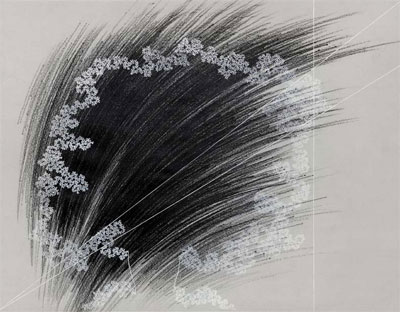
Dwa nieprawdziwe obrazy drzewa VI/3, kredka, olej, papier, 49,3 x 63, 1988
Two False Images of a Tree VI/3, crayon and oil on paper
The same object is presented many times from different
points of view, which suggests relativity of various
perceptions of reality. Similarly the question of identity
comes into our mind when in one of the works we observe
a set of slats, an object counterpart (in quantity and length)
of lines that make up a given shape. In other doings the
image of a tree first put on the profile of a two-dimensional
figure and then a solid figure is subject to changes being
a result of the impact of the background shapes. When
placed on the spatial material it changed the status of its
existence.
Herein we are concerned with a specific kind of relativism.
Is the picture still the same image? Is it still the image of the
same object if it takes various shapes, depending on the
character of the operation? Thus, is the comprehension of
the notion still the same when we change the context in
which we function?
Acting with tracing paper (to which the motif of a cross or
a triangle is subject), its multiple folds and a simultaneous
transformation of an image which it depicted, increase
an impression of illegibility of the basic meaning of the
element; like clichés too often used in a variety of contexts.
In all stages mentioned above the image was deformed, yet
it still existed; it not only did not disappear but it transferred
into self-quotations, it also became an element of real
space, first by introducing textural elements, and later by
becoming components of the real space of an installation
and then of the time and space of a performance.
Moreover, all these activities simultaneously stressed relativity
of our perception. Considering the artist’s position, they
somehow devalued the conviction concerning the likelihood
of existence of the only true System whose goal was to
present the matter in the way to reveal the essence of what
is spiritual, absolute and universal.
In the early works there was a tree – an emotionally neutral
motive. Then some other motives appeared, burdened with
numerous meanings and possibilities for interpretation
(the cross, the Shield of David). To some extent it might have
been a manifestation of yielding to personal emotions, the
pressure of the external context.
The artist himself stressed the potential presence of a personal,
physical factor – e.g. a sign of exhaustion. Was not the
decision to abandon photography as a medium in the
process of preserving and duplicating an image associated
with a desire to fill a work of art with some emotions
connected with the imperfections of the work done by the
human hand? And does not the very effort of calligraphing
the juxtaposed fragments of the image of a tree mean
a kind of meditation – a specific philosophy of life?
And what about emotions associated with the experience
of everyday social, political, cultural reality? Is not the
use of imagery motives rooted in culture, ambiguously
meaningful, a trace of such emotions? These signs
can obviously be regarded as a set of lines apt for
transformations, however, the effects of transformations
deliberately performed on them, together with their
meaning conveyance do not merely occur as a random
act, they are predictable. Apart from the diagnosis of the
state of the depicted semantic areas in culture (superficial
treatment or Sacrum decline, cultural transformations,
conflict of value systems of the contemporary world) the
artist wanted to say about a sign worn out by the superficial
approach to the sphere it evokes, or the separation of the
sign from its essential designatum.
And is that by chance that the paintings whose basic
imagery motives were shadowed were created in the mid-
1980s? Do not they contain echoes of the events of that
time? The incompleteness of imitating the visual sphere in
these paintings could be a reflection of the incompleteness
of existence.
In his works, with the use of self-quotations, Grzegorz
Sztabiński – through retrospection – referred to the past as
well. It was obviously an attempt to capture the work of
art as a whole, and to find the primary sense. Taking the
character of the image memory into account, the memory
which does not exactly preserve the features of creation
chronology, it was not possible to reach that goal. It seems
however, that the artist was not only motivated by a desire
(or a hope) to keep the logical memory of the whole artistic
process, but also by the emotional purely human desire
to preserve moments from the past, to form them into
a coherent continuous whole.
Turning to nature was a special moment in Grzegorz
Sztabiński’s work. Nature and its deliberate dynamism had
been primary and standard for art for a long time, being in
the past a criterion of assessment of what is well-founded
in artistic endeavours. Art transcends the world of nature
and together with science, morality and religion it creates
the world of culture.
The elements of nature which appear in Grzegorz
Sztabiński’s creation build or participate in creating
installations. They become a more and more important point
of reference, though the number and character of these
elements are limited. What happened in the installations
was a transfer from a two-dimensional image of a tree,
through its presence intensified by texture, up to the physical
existence in the form of twigs. The arrangements of
twigs and slats are considered by the artist to be signs of
a mysterious language which nature uses to talk to us.
The artist emphasised his strong emotions concerning the
mysterious character of nature and the need to read out
the signs of nature to discover the truth hidden there.
The numerous actions mentioned above accentuate
the significance of the emotional factor in Grzegorz
Sztabiński’s work. The art, that, considering its nature,
should be reserved and calculated, dominated by the
philosophical aspect in its concept, and the geometric one
in the image, was in this way really ‘human’.
In the course of the artistic process of verbalising an
abstract idea the artist juxtaposes elements deriving from
a realistic (real) background, such as e.g. images (signs) of
trees, branches – in his installation he uses everyday objects
as well – composing them with abstract, geometric forms.
It was stressed many times that the aesthetic value, the side
effect here, is not the superior goal of this art. Nevertheless
Grzegorz Sztabiński’s works evoke unquestionable
profound visual qualities, they are of great aesthetic value.
Grzegorz Sztabiński’s art is not merely a reflection of
intellectual considerations, but also a material construct
containing some specific visual motives, subject to the
rules of artistic formation of an image. Even the way the
effects of logical operations (diagrams, grids), equivalents
of abstract phenomena are formally presented on a plane,
depends on the author’s will.
The aesthetic values of paintings and drawings as well as
Grzegorz Sztabiński’s spatial compositions are irrefutable.
The artist’s works are dominated by subtle plastic actions.
A drawing of the crown of a tree, made with great precision
– even for that reason that it is necessary to repeat it – creates
a kind of sophisticated ornament. Fragments of the tree
crown also look as perfect images (though they are not),
showing the similarity of a fractal to its part. We take great
pleasure in following the ducts (one- or multi-coloured)
contrasting with the background, which give way to lines
reflecting that element of nature and rhythms that are the
effect of some definite presumptions, according to which
the components of the whole sophisticated composition
are organised.
We feel that its particular parts (planes dominated by
the rhythms of tree contours, those characterised by
distortions as well as ‘the realistic images of a tree against
the background’ or geometric symbols) were arranged
with great care and skill, as far as their size, priority and
mutual proportions were concerned. The artist uses the
plane to juxtapose abstract and organic forms, irregular
dispersed (the tree crown, the lines of frottage…) with
geometric ones.
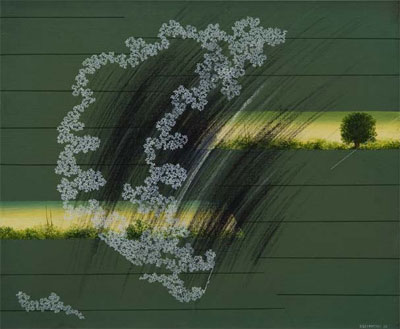
Obraz drzewa, kredka, akryl, olej, płótno, 54 x 65 cm, 1988
Image of a Tree, crayon, acrylic and oil on canvas
Some of Grzegorz Sztabiński’s paintings, though they are
characterised by obvious care and the tranquillity typical
of any complex reflection, are more dynamic. Not only is it
expressed by stronger accents of emotions, but also by the
intention to test some rules with regard to the phenomenon
of movement – such disturbances as dislocations, rotation,
suggesting ‘vanishing’ perspective. This kind of endeavours
can also be considered to foreshadow the advent of the
next stage – going beyond the two-dimensional space
into the area of the installation or performance.
In the artist’s works colour is subordinate to line. Colouring
focuses on a limited palette. It comprises perfectly sensed
reds, metaphysical blues, greens and browns juxtaposed
with black in Sposoby bycia (Manners of Being),
phenomenal, tonally distinguished colours in Pamięć
obrazu (Memory of the Painting), palettes of greens and
blues in Milcz±ce collage’e (The Silent Collages), a variety
of ‘dimmed’ browns and greys in Między-rzeczy (Inter-
Objects) or Cięcia (Cuttings).
What is striking here are the attempts to expand the
paintings’ space obtained by juxtaposition of coloured
and black planes, by placing fragments of the composition
in shadow, half shadow and light, when the shadow falls
widely on the plane of the painting owing to the use of
different kinds of perspective; in the installation the space
of the exposition, naturally deep as it was expanded by
means of the elements lying on the floor and those hanging
on the walls, is even additionally deepened by the perspective
exposition of the drawn objects.
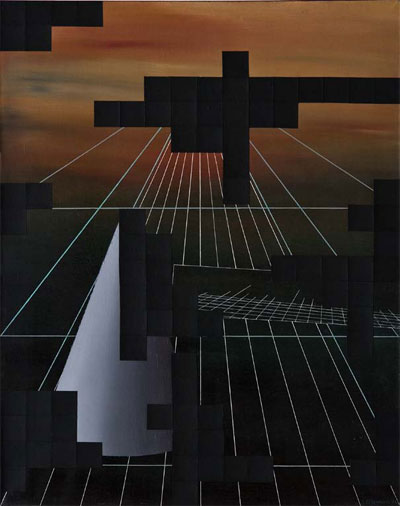
Milcz±cy collage VIII, olej, papier, płótno, 81 x 65 cm, 1988-2004
The Silent Collage VIII, oil and paper on canvas
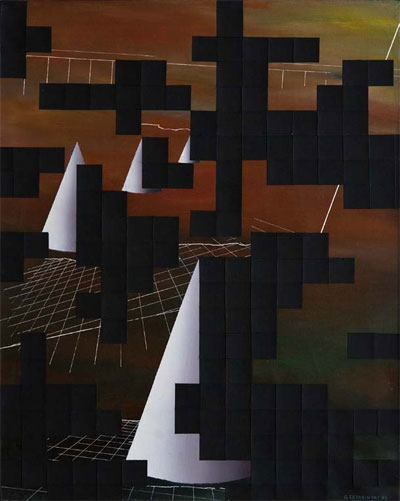
Milcz±cy collage IX, olej, papier, płótno, 81 x 65 cm, 1988-2004
The Silent Collage IX, oil and paper on canvas
The paintings, in their spatial character created by multilayered
representations, obtained by mutual contrast of the
representational and abstract elements, simultaneously
depicted making their way to the Absolute, the Rule, the
Whole by penetrating the spheres of the unknown. In
three-dimensional works this antinomy occurs as well:
the recognizable objects and their images are followed by
traces of geometric actions performed on these objects.
These endeavours – apart from being representations
of relativity in identification of an object and its
representations – are also an attempt to recognize varied
spaces where respectively: the object, its visual image
and the reflection concerning their mutual relationships
function. It also reveals, in a metaphorical way, the
development of a concept, its recedence, sometimes its
deconstruction and deterioration (moving away to the
shadow sphere).
Some researchers state that, when considering Grzegorz
Sztabiński’s works, the viewer is able to notice mainly,
or merely the aesthetic values of a work of art (colour
arrangements, shade and light effects, the rhythm of the
elements, perceptible lines of tension), however, it is possible
to conclude that the means of expression properly selected
by the artist undoubtedly draw our attention to the very
essence of the operation. Inquisitiveness of viewers who,
for the last few decades, have been used to Neo-Avantgarde
art, as well as their increased cultural competence
are the reason why they are able to understand at least
a part, an outline of the game which Grzegorz Sztabiński
plays in the realm of art.
As beholders we first of all succumb to the feeling that
we face a work of art that is genuine, reliable and honest.
It happens that even if we do not know the rules that
determine a given artistic message we take great pleasure
in having contact with it. Grzegorz Sztabiński’s work is
a case in point.
The search within the universal values and their
relationships, because of its logic and order, evokes
a specific sense of… beauty. As beauty can be discovered
in many ways: it is the beauty of what is presented, the
beauty of the way it is made, the beauty of an artistic
concept with its consistency as well as the real beauty
when a work of art truly enriches man and the world.
In the kind of art intended to be a mirror reflection of reality,
the relations, connections and proportions which have
an impact on the composition and appearance of the
elements seem to give us certainty, they create an illusion
of the world’s cognition. In common perception they are
a source and a guarantee of beauty.
Although Grzegorz Sztabiński does not resign from the
tangible character of art, the aesthetic factor appears to
be of secondary significance. What is essential here are the
rules controlling the composition of the elements, inspired
by mathematical, logical laws or created by the artist, not
a reflection of the visible world based on the observation
of reality. The fundamental oppositions were illustrated
by the artist by means of the similar imagery motives.
However, he used his own varied rules, depending on what
abstract notions he had in mind.
The sense of purposeful and consistent actions (their
precision and accuracy as well) is very clear in these works.
And even when the artist, accepting a mistake (which is an
effect of the search), changes the algorithm – we trust him;
there is a sense of harmony based on the conviction that
the means of expression and the assumed goal have been
properly selected. The difficulty in perceiving the whole of
the phenomena (due to a physical inability to continue
the reflection which is a result of the immanent infinity of
the process or the constant decrease and the final atrophy
of the visual elements) might be a source of subsequent
logical decisions – their tangible sense brings the viewer’s
satisfaction.
In his work Grzegorz Sztabiński tries to convince us that by
means of visual forms we are capable of perceiving only
a part of the phenomenon of existence. The attempt to
make all the processes that take place in it visible is typical
of human beings, yet as the artist’s search proves it is
condemned to failure.
In the artist and philosopher’s endeavours there is an effort
to comprehend and capture the Divine Logic. The creator,
who can not achieve it only with the tools of philosophy,
aspired to do it with the means of artistic expression.
He realises the common desire for cognition, trying to
discover, to understand and to abolish the fundamental
oppositions. Coming across some obstacles on his way, he
absorbs the successive experiences, taking a challenge to
the man, the researcher and the artist.
His creation is due to neither incomprehension nor
certainty and understanding – it is an expression of search,
a desire to reach the truth, despite the fact that at the
moment of failure it would be easy to continue an act of
unreasonable defiance, resigning from all kind of reflection
– as he claimed in his writings.
In the logical sequence of search Grzegorz Sztabiński does
not ultimately offer us the image of what is absolute. The
speculated logic of operations sustains a failure against
the imperfection of reflecting the visual factors. However,
the works are an expression of the world’s improvement
and the natural nostalgia for the ultimate perfection.
Grzegorz Sztabiński’s evolving art is an expression of
transience, a process of changes involved in eternity. The
artist shares a sequence of actions with us, the actions that
are a representation of a given process.
Grzegorz Sztabiński’s attitude is a great pilgrimage
through the area of art and philosophical reflection. The
artist not only wishes to exist in the world but to be there as
a reasonable and creative being
Dariusz Le¶nikowski
Transl. Elżbieta Rodzeń-Le¶nikowska
Covering, shifting, disappearing
Shifting, covering and removing are frequently employed in
the course of artistic activities. Shifting an element, say, by
moving it from the center of an arrangement to its margin,
it is a procedure which aims to improve the composition or
change its character (e.g. to convert it from open to closed).
Covering, also known as „masking” consists in covering
a certain shape in order to check what the arrangement
of other components would look like should it be omitted.
Disappearance is realized by partial or complete removal
of some form. Typically, these procedures are treated as
purely technical, useful during certain stages of completing
the final version of the work. An artist forgets about them
as soon as he finishes his work. The viewer usually does not
realize whether and which elements of the composition
were subject to the processes described above.
I realized the potential in exposing such actions which,
during normal painterly work or drawing, are treated
as purely pragmatic while I was working on my series
Silent collages/ Milcz±ce collages. The starting point of
these realizations were my oil and acrylic paintings I had
completed in the eighties. Several of them were showcased
at exhibitions, a few were sold, but in general this cycle
failed to give me a sense of satisfaction. In 2004, I used
these paintings in an action which can be described as
„masking” of a kind. I covered places which I found especially
irritating with small squares cut from white or black paper.
The effect encouraged to reflect on its meaning, so I pasted
paper elements on the previously painted canvas. Thus,
I fixed the result of the action of ‚masking’, which in the normal
procedure of painting is removed in the final version of the work.
Thus, paintings became dual in nature. They were connected by
two periods of time, two decisions that were taken.
Pasting pieces of paper onto paintings is associated with
collage. For cubists, dadaists, surrealists and constructivists
this technique was a new way to create works of art. Its
advantage was the possibility of creating a link between
the work and the daily life through a direct transfer of its
parts onto the painting. Collages were thus „eloquent” – in
cubism, they made the meaning of drawn or painted works
concrete, in constructivism, they were the confirmation
of the materialistic nature of the surface and actions
performed on it, in surrealism, they constituted a smooth
transition towards the surreal.
Therefore, the pasted
fragments had to have a distinct character, to be rich in
meaning. In the case of my actions, this situation was
changing. Black squares of paper smothered the earlier
painterly expression. They introduced areas of „silence”.
They questioned the conclusion of the painting process,
expressing doubts about the validity of the solutions
used during it and also provided evidence of the arbitrary
character of considering any result of work as final.
The idea of the painting underwent destabilization, as the
possibility of reenacting the process of transformation was
thus revealed.
I asked myself, therefore, a question whether such a peculiar
performativization could not have appeared previously, in
other forms, in my artistic actions? Reflecting on this issue,
I drew attention to shifting and disappearance occurring
in the painting and drawing cycles I had been producing
for over forty years. They consisted generally of a few
or a dozen works, which differed in that some of their
components were subject to shifts in subsequent projects.
This process occurred in a systematic way. The overall
distribution of elements on the plane remained the same in
the subsequent works comprising the cycle. Only selected
shapes changed their position, gradually being shifted
up or down, to the right or left. Sometimes, the process
of shifting took place in relation to one shape, such as
an outline of a tree.
In subsequent drawings or paintings,
I showed its parts in various configurations (e.g. 1/6, 2/6,
3/6, 4/6, 5/6) in order to eventually provide a complete
shape. Sometimes, I also used a reverse principle, moving
systematically from an entire shape to its parts, and then
disappearance. Later, from the early eighties, I linked this
kind of transformative approach with the change of the
form I used. I still used the shape of a tree but I also used
an outline of an equilateral cross, star, triangle or a specific
letter. I drew a given form of tracing paper, and then I folded
the paper, which led to unexpected transformations
of the initial theme. Drawings on tracing paper I either
included into my work, or moved the resulting deformed
shapes onto the surface of paper or canvas. This resulted
in destabilization of the patterns of familiar forms. They
were simultaneously associated with what we know,
while going beyond the dichotomous oppositions which
we use in everyday life and which we also employ in art.
What followed was a dynamic oscillation between the
initial shape and the directly observed modified forms.
Sometimes, I placed such an initial shape in the work
treating it as a reference point, at other times I let the
mutated elements to function independently.

Między skończono¶ci± i nieskończono¶ci± II, tusz, papier, 50 x 50 cm, 1979
Between the Finite and the Infinite II, India ink on paper
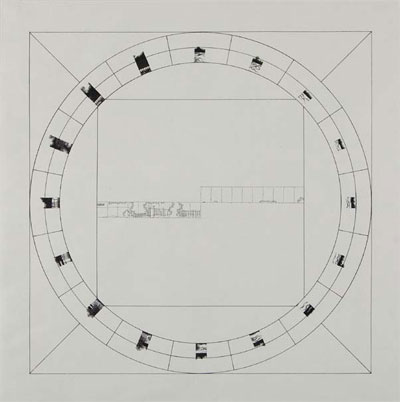
Między skończono¶ci± i nieskończono¶ci± V, tusz, papier, 50 x 50 cm,1979
Between the Finite and the Infinite V, India ink on paper
Operations described were always conducted
systematically. The basis of the activities were numerical
sequences, in various ways related to the principles of
transforming the elements. The reason for adopting an
objective basis of the activities („the rules of operation” as
I described it in the title of a series of paintings in 1975) was
to provoke a kind of randomness. I was not attracted by
purely subjective decisions related to the transient emotions
or a free movement of the hand. The unpredictable (and
in this sense, random) nature of the shape undergoing
transformations was to be a result of the application of
the adopted algorithm, and thus in some sense forced
by its relevant characteristics. The element of emotion in
my work was connected with the expectation of what the
result would be of strict adherence to predetermined rules.
Disappearance of elements in the cycles of paintings
or drawings was also a consequence of assumed
transformations or shifts. Steadily moved elements came
to a certain limit (it could be a drawn shape or edge of the
plane) and this situation, to continue their movement in
subsequent work from the same cycle became impossible.
Also, the changes in the shapes were to suggest the
existence of other possibilities of transformation which
I did not include. Therefore, in my comments to these
projects I often suggested that the movement according
to the rules can continue, but outside the area of visibility.
I also encouraged the viewers to continue the activities
which they learned watching the presented works, and
to imagine the infinite development of transformations
suggested in them.
The quest for intellectual stimulation of the audience,
getting them to treat works is not as definitive, optimal visual
solutions, but as a stage of performative transformation,
accompanies most of my artistic activities. In the early
eighties, these suggestions led to singular actions that
can be categorized as performance art. They consisted in
a public presentation of the transformation process which
I applied to the elements that appear on paper or canvas.
I showed the most extensive action of this kind, entitled
Poza obraz (Beyond Painting) for the first time during
the Third International Symposium of Performance Art
in Lyon in 1981. It sparked interest because, in addition to
actions, the performers were then to present their visual art
works. Art critics present at the event emphasized the close
relationship between artistic creativity and the shown
action in the case of my artistic output.
As a consequence of the so-called performative turn in
contemporary art, as well as in theoretical considerations,
emphasis is usually placed on questioning the boundaries
between artistic disciplines. In various areas of art, one
attempts something that resembles a spectacle.
I think
that this also applies to the activities of some artists using
traditional means of art. Then, their thinking and actions
do not culminate in a single work. This is not a realization,
where, by developing the concept, the preparatory phase
and, finally, the execution one aims at a single object
which is the sum of experiences and thoughts. Specific
works are rather stages on the road – illustrating the
state of reflection which will progress further.
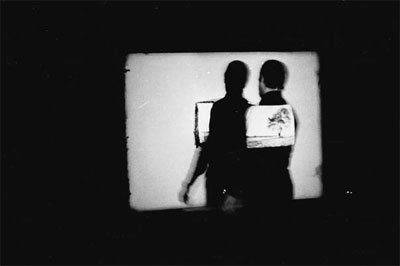

8, 9. Poza obraz, performance, 1981 / Beyond the Picture, performance
Therefore, it
is not contemplation that is expected of the recipient but
interaction. Sometimes, it is physical in nature and consists
in interactive participation in the shaping of an object
or situation. This activity, however, can also be mental in
nature and rely on taking into account factors related to
the development of something, the occurrence of shifts,
noticing covering or unveiling, realizing the disappearance,
which consists only in going beyond the area of visibility,
or sometimes a complete annihilation.
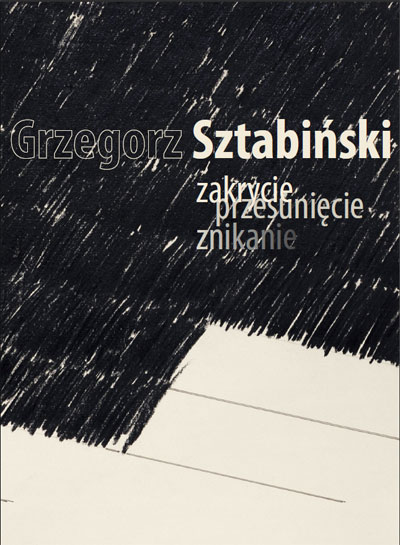
 KATALOG
KATALOG
|
|
|
 |










